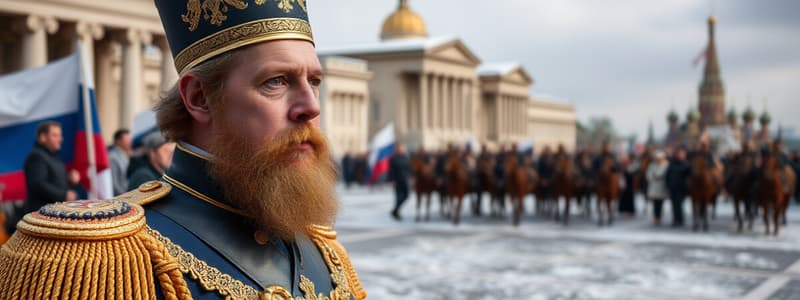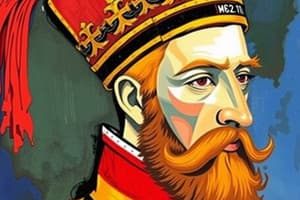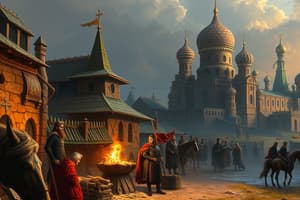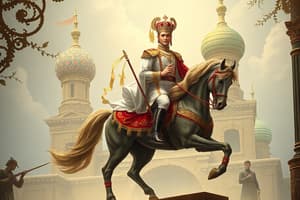Podcast
Questions and Answers
What was a primary focus of the peasantry during the time of Alexander II?
What was a primary focus of the peasantry during the time of Alexander II?
- Advocating for social changes
- Surviving and managing daily life (correct)
- Understanding new political ideologies
- Participating in industrial activities
Which of the following changes occurred in Russia during Alexander II's rule?
Which of the following changes occurred in Russia during Alexander II's rule?
- Development of a modern banking system (correct)
- Establishment of a political democracy
- Transition to an entirely industrial economy
- Complete eradication of the peasant class
What aspect of the economy remained predominant in Russia around 1881?
What aspect of the economy remained predominant in Russia around 1881?
- Industrial production
- Export-driven economy
- Service-based economy
- Agricultural production (correct)
Which of the following best describes the social changes during Alexander II's reign?
Which of the following best describes the social changes during Alexander II's reign?
What hindered the potential for greater change in Russian society under Alexander II?
What hindered the potential for greater change in Russian society under Alexander II?
What percentage of land were peasants reported to be farming less by the time of Alexander II's reforms?
What percentage of land were peasants reported to be farming less by the time of Alexander II's reforms?
Who was appointed as the Minister of Finance in 1862 to stimulate industrial growth in Russia?
Who was appointed as the Minister of Finance in 1862 to stimulate industrial growth in Russia?
What was one major change Reutern implemented in the financial system of Russia?
What was one major change Reutern implemented in the financial system of Russia?
By 1878, how many municipal banks were established in Russia under Reutern's financial reforms?
By 1878, how many municipal banks were established in Russia under Reutern's financial reforms?
What significant communication development occurred alongside the expansion of railways in Russia?
What significant communication development occurred alongside the expansion of railways in Russia?
What was a major benefit of foreign investment in Russian industries?
What was a major benefit of foreign investment in Russian industries?
How much did factory production value increase from 1863 to 1879?
How much did factory production value increase from 1863 to 1879?
What was the approximate total mileage of railway tracks by 1881?
What was the approximate total mileage of railway tracks by 1881?
What was a key change for Jews in Russia under Alexander II?
What was a key change for Jews in Russia under Alexander II?
Under Alexander II, which industry saw significant improvement due to foreign investment?
Under Alexander II, which industry saw significant improvement due to foreign investment?
How did Alexander II's approach differ from traditional tsarist rule?
How did Alexander II's approach differ from traditional tsarist rule?
What role did the nobility experience during Alexander II's reign?
What role did the nobility experience during Alexander II's reign?
Which of the following was NOT a part of Reutern's financial reforms?
Which of the following was NOT a part of Reutern's financial reforms?
What was the grain export volume in Russia in 1880 compared to that in 1855?
What was the grain export volume in Russia in 1880 compared to that in 1855?
Which factor contributed to the slow agricultural productivity increase during Alexander II's reign?
Which factor contributed to the slow agricultural productivity increase during Alexander II's reign?
How much did agricultural output increase by 1900 compared to during serfdom?
How much did agricultural output increase by 1900 compared to during serfdom?
What role did the 'mir' play in the agricultural structure during this period?
What role did the 'mir' play in the agricultural structure during this period?
What was the population of Russia in 1858?
What was the population of Russia in 1858?
By what year did Russia's population almost double to 125 million?
By what year did Russia's population almost double to 125 million?
What factor hindered the movement of landless peasants to urban areas?
What factor hindered the movement of landless peasants to urban areas?
Which country was able to double its agricultural production during Alexander II's reign?
Which country was able to double its agricultural production during Alexander II's reign?
What was the primary impact of the Emancipation of the Serfs on the Russian nobility?
What was the primary impact of the Emancipation of the Serfs on the Russian nobility?
Which reform led to a decrease in the ability of the nobility to influence legal outcomes?
Which reform led to a decrease in the ability of the nobility to influence legal outcomes?
What was one consequence of Miliutin’s military reforms for the nobility?
What was one consequence of Miliutin’s military reforms for the nobility?
How did educational reforms during Alexander II's reign affect the Middle Class?
How did educational reforms during Alexander II's reign affect the Middle Class?
What factor contributed to the lack of political rights for the Middle Class during Alexander II's reign?
What factor contributed to the lack of political rights for the Middle Class during Alexander II's reign?
In what way did the working class begin to form during Alexander II's time?
In what way did the working class begin to form during Alexander II's time?
What was one of the major challenges faced by serfs after their emancipation?
What was one of the major challenges faced by serfs after their emancipation?
How did the Zemstva affect the nobility's societal role?
How did the Zemstva affect the nobility's societal role?
What position did the majority of ministers under Alexander II come from?
What position did the majority of ministers under Alexander II come from?
Which of the following best describes the overall change for serfs after 1861?
Which of the following best describes the overall change for serfs after 1861?
What was a key outcome of the judicial reforms for the Middle Class?
What was a key outcome of the judicial reforms for the Middle Class?
What was a significant shift in education for the Middle Class during Alexander II's reign?
What was a significant shift in education for the Middle Class during Alexander II's reign?
Which factor hindered serfs' development after their emancipation?
Which factor hindered serfs' development after their emancipation?
How did the assassination of Alexander II impact the path of the Middle Class?
How did the assassination of Alexander II impact the path of the Middle Class?
Which sector began to significantly develop under Alexander II's rule, marking the origins of the working class?
Which sector began to significantly develop under Alexander II's rule, marking the origins of the working class?
Flashcards are hidden until you start studying
Study Notes
Economy Under Alexander II
- Agriculture remained the cornerstone of the Russian economy during Alexander II's reign.
- Grain exports increased to 86 million tons by 1880, up from 1855, but productivity grew only 20% by 1900 compared to serfdom.
- Russia lagged behind developed countries, and redemption payments limited investment and innovation in agriculture.
- The mir restricted movements towards agricultural modernization, focusing on ensuring food supply over efficiency.
- Population nearly doubled from 68 million in 1858 to 125 million in 1897, but peasants farmed less land due to economic constraints and high redemption payments.
Industrial and Financial Reforms
- In 1855, Russia was primarily agrarian and needed structured management for industrial growth.
- Reutern, appointed Minister of Finance, unified the treasury and introduced annual budgets starting in 1862.
- Expansion of financial institutions resulted in 278 municipal banks and over 500 loan associations by 1878, improving investment opportunities.
- Foreign investors played a critical role, bringing expertise and facilitating industrial development, especially in textiles and oil.
- Industrial output rose significantly from 352 million to 909 million Roubles between 1863-1879.
Transport and Communication Advances
- Railway expansion was pivotal for industrialization; track length grew from under 700 miles to over 14,000 miles by 1881.
- Grain exports via rail reached 86 million tons by 1881, underlining railway importance to the agrarian economy.
- The telegraph network expanded dramatically from 1,300 miles in 1855 to 50,000 miles by 1881, improving communication and commerce.
Jewish Economic Activity
- Pre-1855 restrictions on Jewish trade were relaxed, allowing greater economic participation.
- New laws in 1859 and subsequent years enabled Jewish merchants to operate freely throughout the Empire.
- The 1865 Policy on Jewish Artisans abolished the 'pale,' granting artisans more mobility and opportunity.
Social Changes
- Alexander II maintained autocratic power, with little change to the authority of the tsar.
- The nobility experienced significant decline in influence due to serf emancipation and changes in the legal and military systems.
- The middle class felt disappointed despite some educational and economic opportunities, leading to resentment and revolutionary sentiments.
- The working class began to emerge as industries developed, foreshadowing future societal shifts under Nicholas II.
- For serfs, the 1861 emancipation freed 23 million but imposed long-term redemption payments, leading to persistence of poverty and limitation on freedoms.
Conclusions on Socio-Economic Change
- Marked changes included the emancipation of serfs, industrialization beginnings, expanded railways, and a new banking system.
- Continuity remained in the agrarian nature of the economy and the peasants' challenges, limiting fundamental societal change.
- Despite efforts at reform, restrictive controls hampered the full potential of economic improvements, leading to gradual rather than revolutionary change.
Studying That Suits You
Use AI to generate personalized quizzes and flashcards to suit your learning preferences.




